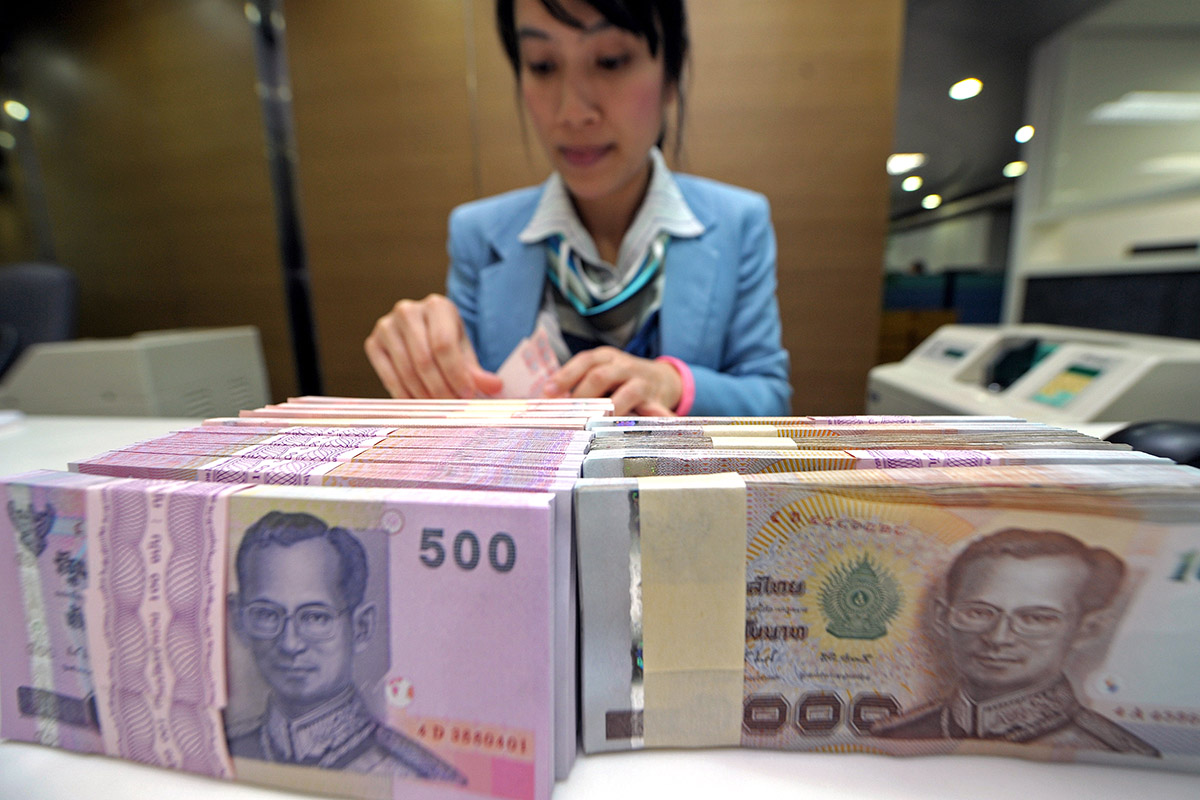India and Thailand may have to give freer rein to the rupee and baht this year to avoid triggering U.S. accusations that they’re manipulating their currencies to support exports.
The Reserve Bank of India has already exceeded a key threshold on how much it can intervene to curb the rupee’s gains that the U.S. monitors, according to Nomura Holdings Inc. Policy makers in Thailand have also passed this level with the baht, said Bank of Tokyo-Mitsubishi UFJ Ltd.
Should the two countries’ central banks seek to assuage U.S. concerns -- and avoid a range of possible penalties -- it would likely lead to gains for their currencies, potentially reducing their export competitiveness. For all the efforts of policy makers last year, the baht appreciated almost 10 percent against the dollar, while the rupee climbed 6.4 percent.
The two nations posted the biggest percentage gains among Asian emerging markets in their foreign-exchange reserves last year, more evidence their central banks are buying dollars to curb currency gains. China, South Korea and Taiwan -- which have been previously called out by the U.S. -- recorded some of the smallest increases.
The threat of U.S. complaints will support more appreciation in Asian currencies in general this year, said Rajeev De Mello, head of Asian fixed income at Schroder Investment Management Ltd. in Singapore. There’s been a notable reduction in intervention from the three North Asian central banks, according to Schroder Investment and Australia & New Zealand Banking Group Ltd.
“Thailand and India have been two exceptions, which have been actively accumulating reserves to stem appreciation pressure on their currencies,” said Khoon Goh, head of research at ANZ in Singapore. Thailand isn’t one of the top 12 trade partners that the U.S. normally focuses on but could find itself under scrutiny if the net is cast wider, Goh said.
The rupee and baht have made strong starts to the year, gaining 0.5 percent and 0.6 percent against the dollar , respectively, so far in 2018.
While the U.S. hasn’t branded any country a manipulator since 1994, meeting two of the following three criteria will get you on the monitoring list:
A trade surplus with the U.S. of 20 billion dollars or more;
A current-account excess of at least 3 percent of gross domestic product; and
Net buying of foreign currencies amounting to at least 2 percent of GDP over a 12-month period.
China and Korea were the only two emerging markets on the list at the last semi-annual report in October, while Taiwan was removed.
India
Nomura said in a Dec. 11 note that the RBI had already passed the 2 percent of GDP annual intervention threshold. The U.S.’s trade deficit with India was 19.7 billion dollars at the end of October, according to data compiled by the U.S. Census Bureau. A persistent current-account deficit -- 1.4 percent of GDP in the third quarter -- would appear to be India’s saving grace.
An RBI spokesman didn’t respond to questions on its intervention policy. The monetary authority has consistently said in the past that it intervenes to curb undue volatility.
The Treasury noted India’s net foreign-exchange purchases in its October report and said it would be closely monitoring the nation’s currency and macroeconomic policies. “Overall, we expect RBI intervention to be constrained by the U.S. Treasury’s focus,” Craig Chan, the global head of emerging-market FX strategy at Nomura in Singapore, said in the note.
Thailand
Thailand’s trade surplus with the U.S. was at 16.7 billion dollars at the end of October, according to the census bureau data, and its current-account excess has been more than 10 percent of GDP for the six quarters through September. The nation has passed the 2 percent intervention threshold and is one of 16 countries cited by the U.S. as running high trade surpluses with it, Bank of Tokyo-Mitsubishi said in a Dec. 26 note.
Thailand is more of a contender than India to be added to the monitoring list, said Vishnu Varathan, head of economics and strategy at Mizuho Bank Ltd. in Singapore. “It’s got a very strong current-account surplus this year, but that trend is going to be watched a little longer.”
BOT spokeswoman Chantavarn Sucharitakul didn’t respond to an email seeking comment.
“The Trump administration will likely continue to try and name and shame countries that run large current-account surpluses and accuse them of currency manipulation,” said Guillermo Felices, London-based portfolio manager at BNP Paribas Asset Management. But it’s unlikely to lead to protectionist measures unless there’s a dramatic rise in the dollar or Trump decides to for domestic political reasons, he said. – Bloomberg
Recommended stories:
